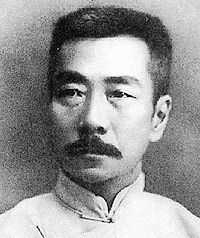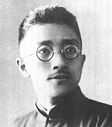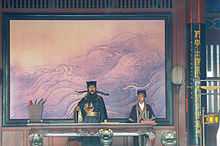The Seven Heroes and Five Gallants
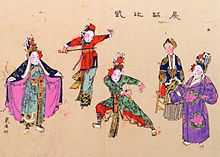 The twins Ding Zhaolan and Ding Zhaohui and their mother watch as Zhan Zhao crosses swords with Ding Yuehua. A Yangliuqing New Year picture, collection of Waseda University. | |
| Author | Shi Yukun |
|---|---|
| Original title |
1. The Tale of Loyal Heroes and Righteous Gallants 2. The Three Heroes and Five Gallants |
| Country | Qing dynasty |
| Language | Written Chinese |
| Genre | |
| Set in | 11th century (Song dynasty) |
| Published | |
| Media type | |
| Followed by | The Five Younger Gallants |
| The Seven Heroes and Five Gallants | |||||||||||||
| Traditional Chinese | 七俠五義 | ||||||||||||
|---|---|---|---|---|---|---|---|---|---|---|---|---|---|
| Simplified Chinese | 七侠五义 | ||||||||||||
| |||||||||||||
| The Three Heroes and Five Gallants | |||||||||||||
| Traditional Chinese | 三俠五義 | ||||||||||||
| Simplified Chinese | 三侠五义 | ||||||||||||
| |||||||||||||
| The Tale of Loyal Heroes and Righteous Gallants | |||||||||||||
| Traditional Chinese | 忠烈俠義傳 | ||||||||||||
| Simplified Chinese | 忠烈侠义传 | ||||||||||||
| |||||||||||||
The Seven Heroes and Five Gallants (七俠五義), also known by its earlier title The Three Heroes and Five Gallants (三俠五義), is a 120-chapter Chinese novel from 19th-century Qing dynasty, generally attributed to pingshu (storytelling) performer Shi Yukun. Based on a transcript of Shi's oral performances, the novel was first published in 1879 as The Tale of Loyal Heroes and Righteous Gallants (忠烈俠義傳), before the title changed to The Three Heroes and Five Gallants in 1883. The Seven Heroes and Five Gallants was first published in 1889, following minor revisions by scholar Yu Yue.
Set in 11th-century Song dynasty, the story detailed the rise of legendary official Bao Zheng from humble beginnings to high office, and how a group of youxia (knights-errant)—each with exceptional martial arts talent—helped him fight crimes and corruption. It is considered the first novel to combine the popular gong'an (crime fiction) and the nascent wuxia (chivalrous fiction) genres,[1] as well as the first mature wuxia novel.[2][3]
Textual Evolution
Shi Yukun's Storytelling and Transcripts
Shi Yukun was a public storyteller who performed mostly in Beijing between 1810 and 1871.[4] He gained particular fame during the reigns of Xianfeng Emperor (1821–1851) and Tongzhi Emperor (1851–1874) telling the legends of Song dynasty official Bao Zheng (999–1062), also known as Bao Longtu (包龍圖; "Dragon-Pattern Bao"). Shi's performances, accompanied by sanxian (lute) playing, would attract audience of thousands.[5] This story proved so popular that publishing houses began acquiring manuscript copies to be circulated and sold.[6] One such copy, apparently a transcript of another storyteller's oral narratives, contained this reference of Shi (translated by Susan Blader):[7]
Let's just take Third Master Shi Yukun as an example. No matter what, I cannot outdo him in storytelling. At present, he no longer makes appearances. But, when he would go to that storytelling hall, he would tell three chapters of a story in one day and collect many tens of strings of cash. Now today his name resounds in the nine cities and there is no one who has not heard of him. I, myself, collect only one or two strings of cash a day for my storytelling, and what can they buy these days?
These early handwritten copies were known as Bao Gong An (包公案; The Cases of Lord Bao) or Longtu Gong'an (龍圖公案; The Cases of Longtu or The Cases of the Lord of the Dragon Pattern), sharing titles with 16th-century Ming dynasty collections. A later version, known as Longtu Erlu (龍圖耳錄; Aural Record of Longtu), lacked the singsong verses and nonsense remarks, and was clearly written down from memory by someone who heard Shi's live performances.[8][9]
The Tale of Loyal Heroes and Righteous Gallants (1879) and The Three Heroes and Five Gallants (1883)
At the beginning of the reign of Guangxu Emperor (1875-1908), a certain "Bamboo-Inquiring Master" (問竹主人; believed to be Shi Yukun himself by some scholars[10]) deleted some supernatural parts of Longtu Erlu and recompiled the material into a 120-chapter book, renaming it The Tale of Loyal Heroes and Righteous Gallants.[11] Minimal revisions by a "Captivated Daoist" (入迷道人) and other efforts by a "Thought-Retiring Master" (退思主人) led to the book being printed by a movable type at the Juzhentang (聚珍堂) in 1879, which caused a sensation in Beijing.[12]
In 1883,[13] the novel was renamed The Three Heroes and Five Gallants,[12] with the "three heroes" being actually four people, namely Zhan Zhao the "Southern Hero", Ouyang Chun the "Northern Hero", and the Ding Zhaolan & Ding Zhaohui twins or "Twin Heroes".[14]
The Seven Heroes and Five Gallants (1889)
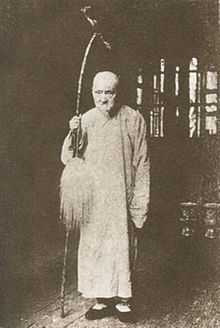
Suzhou-based scholar Yu Yue obtained the book about a decade later from his friend Pan Zuyin. As he explained in the preface of his revised version (translated by Paize Keulemans):[15]
On first looking it over, I had to laugh. "Why, this is The Cases of the Lord of the Dragon Pattern, that's all! How can it be worthy of even a single glance by Pan Zuyin?" However, after I had finished reading it, I came to recognize that the heroic events described in it were new and marvelous, that the feel of its writing was free and unrestrained, that its descriptions were drawn down to the finest detail, and the turns and twists of its plot were tightly structured... Only a plain-narrative novel like this can be considered a truly unique piece of writing in the world.
Being a philologist, most of Yu's edits were textual and superficial, including:
- He changed the title to The Seven Heroes and Five Gallants, because he reasoned that the Ding twins being 2 people cannot be considered just 1 Hero. He also considered Ai Hu, Zhi Hua and Shen Zhongyuan "heroes", even though Zhi and Shen do not have the word "hero" in their nicknames.[14]
- He changed a character's name from Yan Chasan (顏查散) to Yan Shenmin (顏眘敏, notice how much the Chinese characters resemble each other) because he found "Chasan" too "uneducated" for someone of a scholar-official background.[16]
The only major change from Yu Yue was that he completely rewrote Chapter 1, which was previously titled "The Crown Prince is Substituted at Birth by a Scheme; the Imperial Concubine is Rescued by a Heroic and Gallant Martyr" (設陰謀臨產換太子 奮俠義替死救皇娘) and tells of a fictional story that does not follow history. Yu found the story absurd and rewrote the chapter according to the standard history book History of Song, also changing its title to "Using Official History to Refer Longtu's Crime Cases; Lord Bao Begins the Book Full of Heroes and Gallants" (據正史翻龍圖公案 借包公領俠義全書). However, he did not change later chapters which follow up on that substory, resulting in slight inconsistencies.[17]
Despite his pedantry, his revised version, which was published by Shanghai's Guangbaisongzhai (廣百宋齋), became the predominant version throughout China, particularly in South China.[18]
Plot Outline
The novel can be roughly divided into 2 parts, with the first 27 chapters focusing on Bao Zheng and his legal cases[19] (gong'an genre) and the remaining 93 chapters focusing on the heroes and gallants (wuxia genre). Stories from the first part were largely taken from literary and oral traditions and as such contain supernatural materials (what "Bamboo-Inquiring Master", possibly Shi Yukun himself, described as "the occasional strange and bizarre event"[20]). In comparison, the second part exclusively represents Shi's creative genius[10] and is completely devoid of superstition. (The only bizarre story in the second part is similar to the European "Lady with the Ring" tale — a girl waking up in her coffin after a visit by a grave robber. However, accidental premature burial has been documented even in modern days.)
Lord Bao's Legal Cases (Chapters 2-27)
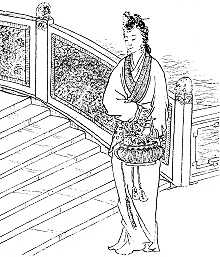
Bao Zheng was abandoned by his superstitious father right after birth and persecuted by his second sister-in-law as a child, but he grew up to be a highly educated scholar. On the way to the capital Kaifeng for the imperial examination, Bao was trapped by murderous monks but "Southern Hero" Zhan Zhao saved him. Bao was appointed a magistrate and solved the cases of the bloody handprint, the fan pendant, and the black crock. Later he became the prefect of Kaifeng and with the help of strategist Gongsun Ce and 4 bandits-turned-constables, solved the cases of the woundless corpse, the headless corpse, and the corpseless head.
Bao traveled to Chenzhou to investigate marquis Pang Yu's corruption allegations. Pang, who not only embezzled relief funds but also kidnapped numerous women, sent assassins to stop Bao. Zhan, wandering in the region on his own, foiled Pang's plot by notifying Bao, and Pang was executed by Bao.
On his way back to Kaifeng, Bao met a woman who claimed to be the mother of the reigning Emperor Renzong. Dozens of years ago, she had been Consort Li, an imperial concubine of Emperor Zhenzong's, before falling out of favour for supposedly giving birth to a bloody dead wild cat, when in fact her newborn son was secretly swapped by a jealous Consort Liu plotting with eunuch Guo Huai. The infant was rescued by maid Kou Zhu, eunuch Chen Lin and the Eighth Prince to eventually become Emperor Renzong. As Kou had died, Gongsun ingeniously had a woman dressed as Kou's ghost to retrieve a confession from Guo.
Zhan was summoned before Emperor Renzong and given the title "Imperial Cat".
Five Rats In the Capital (Chapters 28-58)
Zhan traveled to Jasmine Village, home of the twins Ding Zhaolan and Ding Zhaohui, and got engaged to Ding Yuehua. He also met Lu Fang the "Sky-Penetrating Rat" of Hollow Island, and learned that Lu's youngest sworn brother Bai Yutang the "Brocade-Furred Rat" was traveling to Kaifeng to challenge him, taking offense at the "Imperial Cat" nickname.
Meanwhile, a poor scholar Yan Shenmin (Yan Chasan in The Three Heroes and Five Gallants version) was also traveling to Kaifeng to marry his fiancee Liu Jinchan. He met Jin Maoshu, a man dressed in rags who sponged on him for food and lodging to the point that Yan had to pawn his clothing to pay their bills, with Jin paying nothing. Despite protests by his servant, Yan saw Jin as a friend and became his sworn brother. He reached his destination, but his father-in-law-to-be saw his destitution and wanted to call off the engagement. Liu Jinchan, however, despised her father's attitude and secretly sent a maid to provide Yan with money. When the maid was murdered, Yan, although innocent admitted to the crime to protect Liu's reputation. Jin, who was in reality Bai in disguise, secretly notified Bao to look into the case. Bao executed the real murderer and freed Yan, who married Liu.
After an unsuccessful duel with Zhan, Bai went into the imperial palace and killed an evil eunuch. Back home in Hollow Island, Lu sent his other 3 sworn brothers — Han Zhang the "Earth-Piercing Rat", Xu Qing the "Mountain-Boring Rat" and Jiang Ping the "River-Overturning Rat" to Kaifeng to stop Bai's misdeeds. These 3 "rats" instead robbed the birthday gifts intended to celebrate the birthday of Pang Ji, the treacherous grand tutor and Pang Yu's father. Bai also created havoc in Pang's mansion on his birthday.
Lu, also arriving in Kaifeng, was arrested when a never-do-well was accidentally killed. Han, Xu and Jiang attempted to rescue him at night, and Xu was captured. Eventually, Lu, Xu and Jiang all became officials after Emperor Renzong saw their talent, but Han and Bai continued to be on the loose.
Bai stole three treasures from Bao and specifically asked for Zhan to retrieve them. Zhan followed him to Hollow Island but fell into Bai's trap. Ding Zhaohui, Lu, Xu and Jiang together saved Zhan and captured Bai. Bai surrendered to Bao.
Translations
Two English translations are available:
- Song Shouquan (translator) (1997). The Seven Heroes and Five Gallants. Chinese Literature Press. ISBN 7-5071-0358-7.
- Blader, Susan (1998). Tales of Magistrate Bao and His Valiant Lieutenants: Selections from Sanxia Wuyi. The Chinese University Press. ISBN 962-201-775-4.
Song's book is an abridged translation of all 120 chapters. Blader translated roughly a third of the chapters, relatively more faithfully. As Blader used the version before Yu Yue's editorship, Chapter 1 is noticeably different from Song's book.
In addition, two other books contain (largely rewritten) stories from the novel's first 19 chapters:
- Chin, Yin-lien C.; Center, Yetta S.; Ross, Mildred (1992). "The Stone Lion" and Other Chinese Detective Stories: The Wisdom of Lord Bau. M. E. Sharpe. ISBN 0-87332-634-2.
- Hu Ben; Sun Haichen (translator) (1997). Exchanging a Leopard Cat for a Prince: Famous Trials Conducted by Lord Bao. Foreign Languages Press. ISBN 7-119-01896-5.
The novel has been translated into other languages, such as Japanese (by Torii Hisayasu), Vietnamese (by Phạm Văn Điều), Malay (by Oey Kim Tiang), French (by Rébecca Peyrelon), and Russian (by Vladimir Andreevich Panasyuk).
Themes
The novel places great emphasis on Confucian values, such as yi (righteousness) and ren (altruism), which characterize all heroes and gallants. In Chapter 13, the storyteller added a short commentary on the definition of "hero" (translated by Susan Blader):[21]
Zhan Zhao is truly a practitioner of good deeds and righteous acts. He feels at ease everywhere. It isn't really that he must eradicate all evils, but once he sees an injustice he cannot leave it alone. It is as though it becomes his own personal affair and that, precisely, is why he is worthy of the name "Hero".
In addition, the novel also champions personal freedom. In Chapter 29, for example, Zhan Zhao confessed (as translated by Song Shouquan): "As to my promotion to the imperial guard, I find it prevents me from doing what I like best and that is travel around enjoying the beauties of nature. Now I'm tied down by officialdom. If it wasn't for the high regard I have for Prime Minister Bao I would have resigned long ago." His "northern" counterpart Ouyang Chun even shunned Bao and other officials altogether, preferring to help the government on his own, even anonymously. In imperial China, when officialdom was particularly prized and coveted, such statements and actions speak volumes of the author's beliefs.
The last 42 chapters[19] focus on the suppression of a fictitious rebellion. The inclusion of this segment conveyed the author's desire for peace and tranquility, as mid-19th century Qing dynasty was ravaged by numerous bloody rebellions, including the Taiping Rebellion, the Nien Rebellion, and the Panthay Rebellion, which together took tens of millions of lives.[22]
Reception and Influence
Reception
Many 20th-century literary critics also held the novel in high regard. Lu Xun considered the book "outstanding" among "storytelling tales",[24] praising the novel: "Though some of the incidents are rather naive, the gallant outlaws are vividly presented and the descriptions of town life and jests with which the book is interspersed add to the interest."[25] Hu Shih, who favorably compared the characterizations of Jiang Ping and Zhi Hua to those of Aramis and d'Artagnan in Alexandre Dumas' The Three Musketeers,[23] even included this novel among his "National Book List of the Lowest Level" (最低限度的國學書目; i.e. must-read list) for Tsinghua University students.[26] C. T. Hsia commended the language as "a vivid colloquial style that deserves the appellation of 'real pai-hua'..."[27]
Sequels
The Five Younger Gallants (小五義), first published in 1890, proved to be the most popular sequel. Almost immediately afterwards, A Sequel to the Five Younger Gallants (續小五義) appeared, also enjoying wide readership. Both claim authorship of Shi Yukun, although that had been controversial and difficult to prove. Lu Xun believed "these works were written by many hands... resulting in numerous inconsistencies."[28]
These are followed by Another Sequel to the Five Younger Gallants (再續小五義) and a myriad of other sequels created by enthusiasts, with Lu Xun in 1924 counting no less than 24 sequels.[28] These sequels were not popular and are not reprinted today. Jin Yong, who read all the way until The Ninth Sequel to the Five Younger Gallants (九續小五義), wrote: "Other than eroticism and nonsense, nothing else could be found in these sequel books."[29]
Similar novels
In the 1890s, following the publication of The Seven Heroes and Five Gallants, many similar novels appeared. Popular ones include:
- The Eight Elder Gallants (大八義), The Eight Younger Gallants (小八義), A Sequel to the Eight Younger Gallants (續小八義), and Another Sequel to the Eight Younger Gallants (再續小八義) — These novels are also set in the Song dynasty, just a few decades removed from The Seven Heroes and Five Gallants.
- The Seven Swordsmen and Thirteen Heroes (七劍十三俠), set in the Ming dynasty.
- The Nine Gallants and Eighteen Heroes (九義十八俠), also set in the Ming dynasty.
Adaptations
The following is an incomplete list of films and television series featuring fictional characters from The Seven Heroes and Five Gallants. Some also feature characters from its sequels, related Bao Zheng legends such as Chen Shimei, legends from the same historical period such as Generals of the Yang Family, or Chinese mythology.
Films
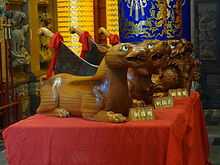
Note: Most of the early films were opera films.
- Redress a Grievance (烏盆記), a 1927 Chinese film.
- Brocaded Mouse (錦毛鼠白玉堂), a 1927 Chinese film.
- Five Mice Make Troubles in Capital (五鼠鬧東京), a 1927 Chinese film.
- The Case of Lost Baby-Prince (狸貓換太子), a 1927 Chinese film.
- Azure-Cloud Palace (碧雲宮), a 1939 Chinese film.
- Breaking Through the Bronze Net (大破銅網陣), a 1939 Hong Kong film.
- Judge Pao vs the Eunuch (狸貓換太子包公夜審郭槐), a 1939 Hong Kong film.
- The Five Swordsmen's Nocturnal Tryst (小五義夜探沖霄樓), a 1940 Hong Kong film.
- The Furry Rat (俠盜錦毛鼠), a 1941 Hong Kong film.
- The Haunt of the Eastern Capital (五鼠鬧東京), a 2-part 1948 Hong Kong film.
- The Fight Between the Honourable Cat and Rat (御貓大戰錦毛鼠), a 1948 Hong Kong film.
- The Junior Hero Ngai Fu (小俠艾虎), a 1949 Hong Kong film.
- The Battle Between the Five Rats and the Flowery Butterfly (五鼠大戰花蝴蝶), a 1950 Hong Kong film.
- Solving the Copper-Netted Trap (大破銅網陣), a 1950 Hong Kong film.
- The Three Battles Between White Eye-Brows and White Chrysanthemum (白眉毛三戰白菊花), a 1950 Hong Kong film.
- Five Little Heroes (小五義), a 1951 Hong Kong film.
- Judge Pao's Night Trial of Kwok Wai (包公夜審郭槐), a 1951 Hong Kong film.
- Judge Pao's Night Trial of the Wicked Kwok Wai (生包公夜審奸郭槐), a 1952 Hong Kong film.
- Adventure of the Five Rats at the Hundred-Flower Tower (五鼠大鬧百花樓), a 1953 Hong Kong film.
- The Burning of Azure-Cloud Palace (火燒碧雲宮), a 1955 Hong Kong film.
- Racoon for a Prince (狸貓換太子), a 1955 Hong Kong film.
- Substituting a Racoon for the Crown Prince (狸貓換太子), a 1958 Hong Kong film.
- Shattering the Copper Net Array (大破銅網陣), a 1959 Hong Kong film.
- Tower of Traps (七俠五義夜探沖霄樓), a 1959 Hong Kong film.
- The Royal Cat and His Opponent (御貓大戰錦毛鼠), a 1963 Hong Kong film.
- The Five Rats' Adventures in the Eastern Capital (五鼠鬧東京), a 1964 Hong Kong film.
- Inside the Forbidden City (宋宮秘史), a 1965 Hong Kong film.
- King Cat (七俠五義), a 1967 Hong Kong film.
- Majesty Cat (南俠展昭), a 1975 Taiwanese film.
- The Wrongly Killed Girl (南俠展昭大破地獄門), a 1976 Taiwanese film.
- House of Traps (沖霄樓), a 1982 Hong Kong film.
- Cat vs Rat (御貓三戲錦毛鼠), a 1982 Hong Kong film.
- The Invincible Constable (御貓愛上錦毛鼠), a 1993 Hong Kong film.
- Love & Sex in Sung Dynasty (宋朝風月), a 1999 Hong Kong film.
- Cat and Mouse (老鼠愛上貓), a 2003 Hong Kong film.
- A Game of Cat and Mouse (包青天之五鼠鬥御貓), a 2005 Chinese film.
Television series
- The Seven Heroes and Five Gallants (七俠五義), a 1972 Taiwanese TV series.
- The Secret History of the Song Palace (宋宮秘史), a 1974 Taiwanese TV series.
- Justice Pao (包青天), a 1974–1975 Taiwanese TV series.
- The Five Younger Gallants (小五義), a 1977 Hong Kong TV series.
- The Five Tiger Generals (五虎將), a 1980 Taiwanese TV series.
- The Iron-Faced Judge (鐵面包公), a 1984 Hong Kong TV series.
- Exchanging A Wild Cat for the Crown Prince (狸貓換太子), a 1984 Taiwanese TV series.
- The New Seven Heroes and Five Gallants (新七俠五義), a 1986 Taiwanese TV series.
- Lord Bao (包公), a 1987 Chinese TV series.
- The New Five Younger Gallants (新小五義), a 1987 Hong Kong TV series.
- The Three Heroes and Five Gallants (三俠五義), a 1991 Chinese TV series.
- Justice Pao (包青天), a 1993 Taiwanese TV series.
- Conspiracy of the Eunuch (南俠展昭), a 1993 Hong Kong TV series.
- Young Justice Bao (俠義包公), a 1994 Singaporean TV series.
- The Seven Heroes and Five Gallants (七俠五義), a 1994 Taiwanese TV series.
- The Bold and the Chivalrous (俠義見青天), a 1994 Taiwanese TV series.
- The White-Eyebrowed Hero (白眉大俠), a 1994 Chinese TV series.
- Justice Pao (包青天), a 1994 Hong Kong TV series.
- Heroic Legend of the Yang's Family (碧血青天楊家將) and The Great General (碧血青天珍珠旗), two 1994 Hong Kong TV series
- The New Seven Heroes and Five Gallants (新七俠五義), a 1994 Chinese TV series.
- Heavenly Ghost Catcher (天師鍾馗), a 1994–1995 Singaporean TV series. Bao Zheng and related characters appear in the segments "Lord Bao Invites Zhong Kui Thrice" (包公三請鍾馗) and "Meeting Justice Bao Thrice" (三會包青天).
- Justice Pao (包青天), a 1995 Hong Kong TV series produced by TVB.
- Justice Pao (新包青天), a 1995 Hong Kong TV series produced by Asia Television.
- Return of Judge Bao (包公出巡), a 2000 Taiwanese TV series.
- Lord Bao's Life and Death Calamity (包公生死劫), a 2000 Chinese TV series.
- The Young Detective (少年包青天), a 2000–2002 Chinese TV series.
- Justice Pao (壯志凌雲包青天), a 2004 Chinese TV series.
- The New Case of Executing Chen Shimei (新鍘美案), a 2004 Chinese TV series.
- The Song Dynasty Stunning Legend (大宋驚世傳奇), a 2004 Chinese TV series.
- The Top Inkstone in the World (硯道), a 2004 Chinese TV series.
- Struggle for Imperial Power (狸貓換太子傳奇), a 2005 Chinese TV series.
- Bai Yutang (江湖夜雨十年燈—白玉堂), a 2005 Chinese TV series.
- Take Wine to Ask the Sky (把酒問青天), a 2007 Chinese TV series.
- Justice Bao (新包青天), a 2008 Chinese TV series.
- The Great Hero Di Qing (大英雄狄青), a 2009 Chinese animation TV series.
- The Black-Faced Great Lord Bao (黑臉大包公), a 2009 Chinese animation TV series.
- Justice Bao (包青天), a 2010–2012 Chinese TV series.
- Qin Xianglian (秦香蓮), a 2011 Chinese TV series.
- Invincible Knights Errant (七俠五義人間道), a 2011 Chinese TV series.
- Female Constable (带刀女捕快), a 2011 Chinese TV series.
- The Legend of Zhong Kui (鍾馗傳說), a 2012 Chinese TV series. Zhan Zhao appears in the segment "Ruthlessly Executing Demons" (除魔無情斬).
- Sleek Rat, the Challenger (白玉堂之局外局), a 2013 Chinese TV series.
- The Legend of Chasing Fish (追魚傳奇), a 2013 Chinese TV series.
- Always and Ever (情逆三世緣), a 2013 Hong Kong TV series.
- Detective Judge (神探包青天), an upcoming Chinese TV series.
- The Three Heroes and Five Gallants (五鼠鬧東京), an upcoming Chinese TV series.
- Hot and Spicy Bai Yutang (麻辣白玉堂), an upcoming Chinese TV series.
- Legends of Bai Yutang's Crime Cases (白玉堂探案傳奇), an upcoming Chinese TV series.
In addition, two TV series set in the Qing dynasty imagined how the novel was created:
- The Strange Cases of Lord Shih (施公奇案), a 1997 Taiwanese TV series. Case 11, "Odd Happenings in Examination Halls" (考場怪譚) stars Hou Kuan-chun as Shi Yukun.
- Thirteen Sons of Heaven Bridge (天橋十三郎), a 2004 Chinese TV series, starring Xu Zheng as Shi Yukun.
See also
- Generals of the Yang Family, Chinese legends also set during 11th-century Song dynasty
- The Three Sui Quash the Demons' Revolt, a 16th-century Chinese novel also set during 11th-century Song dynasty
Notes
- ↑ Deng & Wang, p. 21.
- ↑ Wong, Timothy C., ed. (2003). Stories for Saturday: Twentieth-Century Chinese Popular Fiction. University of Hawaii Press. p. 89. ISBN 0-8248-2624-8.
- ↑ Cao Zhengwen (1994). "Gallant Fiction". In Wu Dingbo; Murphy, Patrick D. Handbook of Chinese Popular Culture. Greenwood Press. pp. 241–242. ISBN 0-313-27808-3.
- ↑ Blader 1998, p. xxiv.
- ↑ Deng & Wang, p. 13.
- ↑ Blader 1998, p. xx.
- ↑ Blader 1998, p. xxi.
- ↑ Deng & Wang, p. 14. Longtu Erlu was not published until 1982, according to Blader 1987, p. 153.
- ↑ Blader 1998, p. xxii.
- ↑ 10.0 10.1 Blader 1998, p. xvii.
- ↑ Deng & Wang, pp. 14–15.
- ↑ 12.0 12.1 Deng & Wang, p. 15.
- ↑ Keulemans, p. 70.
- ↑ 14.0 14.1 Deng & Wang, pp. 16–17, argued, "'Three... and five...' is idiomatic usage in Chinese. In its original sense, it denotes the numerals three and five, like the 'three sage kings and five emperors' of ancient China. Used connotatively, 'three... and five...' mean 'many' or 'numerous'... Even in its original sense, it is correct to count the Southern Hero, Northern Hero and Twin Heroes as three heroes instead of four. We have 'three virtuous kings' in ancient Chinese history: King Yu of the Xia Dynasty, King Tang of the Shang Dynasty and Kings Wenwang and Wuwang of the Zhou Dynasty. They are four kings, not three. But Kings Wenwang and Wuwang both belong to the Zhou Dynasty, so they are counted as one and not two... The usage of 'three... and five...' reveals the richness of Chinese culture. 'Seven Heroes and Five Gallants' is technically correct but less imaginative."
- ↑ Keulemans, pp. 67-68.
- ↑ Because "Shen" (眘) is a rare Chinese character not recognized by most people, Yan Shenmin is often mispronounced as Yan Chunmin (顏春敏) in operas, films (e.g. House of Traps) and TV series (e.g. the 1974 Taiwanese series Justice Pao), as "Shen" appears somewhat similar to the character "Chun" (春). He has also been called Yan Renmin (顏仁敏, as in the 1994 Chinese TV adaptation), also see Blader 1987, p. 154.
- ↑ Deng & Wang, p. 16.
- ↑ Lu, p. 418.
- ↑ 19.0 19.1 Deng & Wang, p. 18.
- ↑ Susan 1999, p. 168.
- ↑ Blader 1998, p. 47.
- ↑ Blader 1998, p. xiv-xvi.
- ↑ 23.0 23.1 Hu Shih, "Preface to The Three Heroes and Five Gallants" (三俠五義序), 15 March 1925
- ↑ Blader 1998, xxviii.
- ↑ Lu, p. 342-343.
- ↑ "胡適晚年讀書"不要命":經搶救保命後看報" [Hu Shih's "Daredevil" Reading in His Later Years: Reading Newspapers After Life Saved]. International Daily News. 22 October 2014.
- ↑ Blader 1998, xxiv.
- ↑ 28.0 28.1 Lu, p. 349.
- ↑ Jin Yong, "On Book Sequels" (書的『續集』), Ta Kung Pao, 22 December 1956.
References
- Blader, Susan (1987). "'Yen Ch'a-san Thrice Tested': Printed Novel to Oral Tale". In Le Branc, Charles; Blader, Susan. Chinese Ideas About Nature and Society: Studies in Honour of Derk Bodde. Hong Kong University Press. pp. 153–173. ISBN 962-209-188-1.
- Blader, Susan (1998). Tales of Magistrate Bao and His Valiant Lieutenants: Selections from Sanxia Wuyi. The Chinese University Press. ISBN 962-201-775-4.
- Blader, Susan (1999). "Oral Narrative and Its Transformation into Print: The Case of Bai Yutang". In Børdahl, Vibeke. The Eternal Storyteller: Oral Literature in Modern China. RoutledgeCurzon. pp. 161–180. ISBN 0-7007-0982-7.
- Deng Shaoji; Wang Jun; (trans. Wen Jingen) (1997). "Preface". The Seven Heroes and Five Gallants. Chinese Literature Press. ISBN 7-5071-0358-7.
- Keulemans, Paize (2007). "Listening to the Printed Martial Arts Scene: Onomatopoeia and the Qing Dynasty Storyteller's Voice". Harvard Journal of Asiatic Studies 67 (1): 51–87.
- Lu Hsun; (trans. Yang Hsien-yi and Gladys Yang) (1959) [1930]. A Brief History of Chinese Fiction. Foreign Languages Press.
| ||||||||||||||||||||||||||||||||
